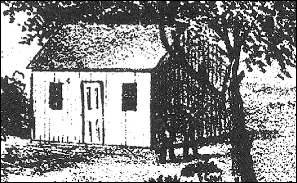Stanislaus - A New County
If it hadn't been for David C. Broderick, a former Tammany Hall politician and honorary New York Fire Department member, who had political ambitions after coming to California in the Gold Rush, Stanislaus County would not have been formed from parts of Tuolumne and later San Joaquin counties. Today we call it gerrymandering: to adjust boundaries to elect one party or another. Broderick wanted to be a US Senator and the formation of a new county would help him achieve his goals.
Political Motivation and a Power Grab Broderick had lost a previous battle to become a senator by one vote in the legislature. With the help of a cronie in Tuolumne County he attempted to add an assemblyman and senator by creating a new county, causing a legislative voting stalemate. Broderick's friend, Lieutenant Governor Purdy would then cast a deciding vote in his favor. The power grab was obvious, and after a long fight, the new county was formed with one assemblyman, but it shared a state senator with Tuolumne County, effectively foiling Broderick's plan.
On April 1, 1854, after a delay caused by Mariposa County's opposition to having a portion of its territory used, Stanislaus County was organized, primarily from Tuolumne County and with a population under 1,000 people. The county was named after Estanislao, a Native American who had fought battles along the rivers in the area. The Stanislaus River had derived its name from him as well. In 1860, a portion of San Joaquin County also became part of Stanislaus County.
Many County Seats The first county seat was Adamsville on the Tuolumne River, but in a November, 1854 election Empire City replaced it. In 1856 La Grange pursued the honor because of its growth and held the title and county records until 1862. When the gold mining town of Knight's Ferry was annexed to the county, after a heated election between the two communities, it became the fourth county seat. Knight's Ferry at the time was a prosperous gold mining town, prominent and wealthy, and it won the election over La Grange by 22 votes.
Wheat, Cattle and Land - The County's Real Gold "When wheat and cattle became important to the settlers of Stanislaus County, the ferry settlements began to grow," according to "100 Years of Progress." Wheat was the primary crop grown in the region, and the years of the Civil War kept the need for wheat, barley and grain at a high level. The late 1860s saw riverboats such as Tulare, Enterprise, Empire City and Hartlett used on the rivers for passengers and transportation of crops. The rivers, ferries and riverboats, were the gateways to outside markets and outside markets needed the products of Paradise Valley.
Paradise City and Tuolumne City, both river towns, prospered, and 1868 was a banner year for wheat. The next year the golden spike was hammered into the ground to join the eastern and western legs of the Transcontinental Railroad in Utah. Construction began on the railroad through the Central Valley in earnest, and any city that didn't pay for the privilege of having the railroad run through it, was bypassed. New towns, laid out by the railroad, took their place. "100 Years of Progress" states, "The old settlements that had served the early pioneer were not always in the right location for the railroad and sometimes the railroad officials and property owners could not agree. The railroad meant life or death to a town. Those towns "on the railroad" prospered; those that were not, died.
The Steel Ribbon Arrives Tinkham's historical take on the railroad in the county follows:
"The railroad is the greatest of builders of town and county. Were it not for the construction and maintenance of four railroad lines through Stanislaus County, the county in all probability today (1921) would not have been much wealthier or with a much larger population than in 1870. Oakdale, Modesto, Turlock, Newman and various other smaller towns would have had no existence and Empire, Paradise, Tuolumne City and Hill's Ferry would have been thriving little towns. But the locomotive whistle was heard and the river towns, almost in a day, were deserted and became cities of history only."
Next: Early History/A Railroad Town/Transformation Previous: Early History/Early Days/Early Regional History
| ||
|
|
Stanislaus County's first courthouse was located in Adamsville on the Tuolumne River. While it was the choice of the first appointed county officials, in November of 1854, an election moved the county seat to Empire City, shown below. This settlement remained the county seat until 1856 when it was moved to La Grange, a more populous gold mining town. The drawings here are from L.C. Branch's history. |
|




